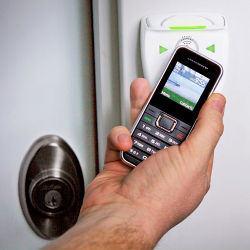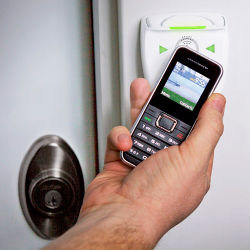
If market activity is any indication, we may be witnessing the dawn of the connected home era.
In January, Google paid $3.2 billion for Nest, a manufacturer of intelligent thermostats and smoke detectors, then followed that up by acquiring the home security company Dropcam. Samsung then purchased Smart Things, a developer of control systems for intelligent homes, in August. Major manufacturers like Haier, Sylvania, and Philips launched innovative smart home products this year, and Revolv, Insteon, and other companies have seen a spike in interest in their hubs, the devices that connect to and control a home’s bulbs, switches, locks, and appliances.
Apple didn’t miss out on the rush, either; in June, the company introduced the new HomeKit feature of its latest iOS release. HomeKit allows your iOS device to communicate with smart bulbs, refrigerators, garage doors, and more. So, instead of buying one of those hubs, or opening one app to dim your lights, another to turn down the heat, and so on, you can simply tell Siri what to do.
Experts say the current boom is more than a passing technological fad. Thanks in part to a drop in the cost of components, the entry point is far more affordable. In the past, upgrading to an intelligent home required an expensive installation process; today, the average consumer can walk into a Home Depot and purchase a Wink control hub, a package of smart bulbs, and a compatible motion detector for less than $200.
Of course, there are still glitches to work out. Some of the new systems have trouble working with one another, and consumers wonder if an electronically controlled lock might be vulnerable to skilled hackers. Yet experts say the combination of the smartphone’s power, the lower cost of critical components, and the boom in consumer interest suggest our homes are only going to get smarter. “It’s changing quickly now,” says Brian Jones, director of the Georgia Institute of Technology’s Aware Home Research Initiative, “but it’s been a long time coming.”
Changing Expectations
Thanks in large part to the power and prevalence of the smartphone, there is a new kind of inevitability to the idea of the connected home, according to Dan Cregg, chief technology officer at Insteon, an Irvine, CA-based connected home products company. A decade ago, when Cregg showed off a new connected home feature to his friends, they would be amazed, but intimidated. Today, Cregg says, the average consumer’s expectations have changed. “To control or monitor or interact with your home through your phone almost seems like second nature,” Cregg says. “When I show people opening and closing my garage door from my phone, I get a much different reaction now than I did 10 years ago. Now it’s, ‘oh yeah, I’ve been meaning to get that.’ “
This shift also carries with it a new set of demands, according to Kent Larson, head of the Massachusetts Institute of Technology (MIT) Media Lab’s Changing Spaces group. Larson, who has been working on smart home technology since 1998, believes the products and companies that emerge from the current crowd will have to allow for customization. “Anyone that suggests there will be a single model for the home of the future doesn’t know what they’re talking about,” Larson says. “The essential feature is that you will have a high degree of choice.”
Until recently, though, companies were not necessarily developing systems with this in mind, resulting in a flood of incompatible products. Some manufacturers built gadgets that transmit and receive signals via Wi-Fi, while others adhere to the 2.4GHz Zigbee communication standard. Still others operate via the 900MHz Zwave protocol. Insteon devices propagate signals in a slightly higher range.
Initially, this mix limited a customer’s options to products compatible with their chosen system. Today, the latest devices are being designed or retrofitted to work with numerous appliances. Insteon develops its own range of bulbs, switches, and more, but the company also released an update that allows its hub to control the Nest thermostat. The next version of the Revolv smart hub will have seven different radios inside, enabling it to automatically communicate with a wide range of smart appliances, bulbs, locks, thermostats, and more; once you plug in the hub, the Revolv device scans your home for existing smart devices, then automatically adds them to its list, allowing you to control everything from a single app.
The Spamming Fridge
This flexibility is critical, because users want to customize their smart homes to their specific needs.
Some consumers are more focused on energy consumption. They want their home to automatically adjust the lights, thermostats, and window blinds every time they leave, whether this action is triggered by a motion sensor, a flipped switch, or a geofence that tracks when a phone leaves the perimeter of the property.
Others are drawn to alerts. Insteon’s Cregg says he receives a text message when the garage door at his second home opens, and he notes that frequent travelers can install leak sensors that let them know if there is a problem with a broken pipe or overflowing toilet.
The idea of a wirelessly connected smart lock raises security concerns for some, but the leading companies rely on strong encryption to keep hackers at bay. The Revolv smart hub, which can connect to smart locks from Yale and Kwikset, uses 128-bit encryption on all communications between devices and the hub. The Zigbee, Zwave, and other protocols, as well as Apple’s HomeKit, rely on end-to-end encryption.
Still, the smart home could create a different sort of security problem, as corporate security firm Proofpoint discovered after analyzing a spam campaign coming in to one of its clients. When the company’s experts back-traced the email to identify its source, “We didn’t see computers,” says Proofpoint vice president of Advanced Security and Governance Kevin Epstein. “We saw home routers and entertainment systems, smart TVs, and a fridge.”
Smart homes are expected to evolve from a suite of appliances that await control to data-collecting machines that respond intelligently and provide feedback.
Epstein and his team determined spammers had set up a program that randomly pinged Internet-connected devices and, upon receiving a reply, queried them to see if they had email capabilities (many smart appliances do, for service and software update purposes). Once it found willing candidates, the program instructed the appliances to dispatch spam on its behalf. There was no harm done to the homes; no milk was maliciously spoiled. In fact, Epstein admits he is not sure how the average consumer should respond if their appliances turn out to be a source of digital spam; “there’s no simple solution,” he says.
Smarts in the Walls
While this unexpected activity suggests consumers might need to find a way to monitor their smart home’s behavior, the appliances will be studying us as well. One of the features that set the Nest thermostats apart is that they aggregate data across their entire user base and, as a result, learn more about behavior, and how to adjust themselves accordingly. Experts say this will become more common as smart homes evolve from a suite of appliances that await control to data-collecting machines that respond intelligently and provide valuable feedback.
MIT’s Larson notes that in the home of an elderly person, a smart home system could alert caregivers to potentially significant behavioral changes. For example, if an elderly man living alone opens his fridge 25 times per day on average, then one day doesn’t open it at all, this might signal the need for some sort of intervention.
In the long run, Larson envisions the intelligence in our homes expanding beyond expected items. His group’s CityHome project centers around a 200-sq.-ft. apartment outfitted with a moving, mechanized module that includes office space, a dining table, and a bed. Users can transform the space, via a digital interface, to suit their current activities. While the CityHome project was conceived in part as a way to save space in urban environments, Larson sees it as a new kind of smart home as well, since it moves intelligence into the walls and furniture. “We think of it as the next step in the Internet of Things,” Larson says. “We’re connecting things that were not previously connectable.”
The connected homes of the future could also incorporate domestic and service robots, according to the Aware Home Research Initiative’s Jones. For the next few years, though, Jones believes smart homes will follow the pattern of the smartphone’s evolution. “Just as everyone finds a different way to use their smartphone to fit their needs, smart home components have finally hit the market in such a way that the general population can customize their experience,” he says. “You’re going to see smart homes go to a completely different level. As this opens up more, I think it is going to take off.”
Further Reading
The Connected Home: The Future of Domestic Life, ed. Richard Harper. Springer-Verlag Books, 2011.
Kientz, J.A., Patel, S.N., Jones, B., Price, E., Mynatt, E.D., Abowd, G.A.
The Georgia Tech Aware Home, Extended Abstracts on Human Factors in Computing Systems, p. 3675–s3680.
Brush, A.J.B., Lee, B., Mahajan, R., Agarwal, S., Saroiu, S., Dixon, C.
Home Automation in the Wild: Challenges and Opportunities, Proceedings of the SIGCHI Conference on Human Factors in Computing Systems, p. 2115–2124.
Larson, K.
The Home of the Future, A+U magazine, edition 361, October 2000.
MIT Media Lab CityHome
A video introduction to a smart, transformable apartment: http://bit.ly/RABVPX





Join the Discussion (0)
Become a Member or Sign In to Post a Comment